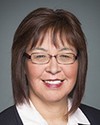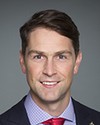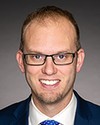That basically wraps up your allotted time.
We move on to MP Georgina Jolibois.
Evidence of meeting #94 for Indigenous and Northern Affairs in the 42nd Parliament, 1st session. (The original version is on Parliament’s site, as are the minutes.) The winning word was community.
A recording is available from Parliament.
Liberal

The Chair Liberal MaryAnn Mihychuk
That basically wraps up your allotted time.
We move on to MP Georgina Jolibois.
NDP

Georgina Jolibois NDP Desnethé—Missinippi—Churchill River, SK
Thank you very much. I am a Dene from northern Saskatchewan, and we share the same common themes you're sharing. I come from a municipal background, though a first nation. I evacuated people, went through the same process, and have the same concerns.
For today's purpose, I would like to take it in a different direction, if you could bear with me. Where I come from, climate change impacts not only forest fires, but the house fires we're talking about in our communities. In your region, is there an impact that you see or that you know of? The question is for both of you.
Oneida Nation of the Thames
In our community, we have definitely noticed the change with regard to the temperature variations, and some of our elders have noticed that as well. The climate has changed with respect to being hotter. Summers are longer and drier, and that creates the conditions for these types of things.
We are all going to be participating in a climate change symposium within the next couple of weeks, so hopefully we'll have a better idea in terms of what those impacts will be and what we're trying to do to address them.
General Manager, Emergency Preparedness and Planning, Public Safety, Mohawk Council of Kahnawake
Yes, I have noticed an impact when it comes to climate change and our weather patterns. For the very first time, this past fall, I actually had to put out a tornado warning in our area. We're just south of Montreal. We're on the other side of the St. Lawrence River. For the very first time, I put out a tornado warning, because one was spotted close by. That would never have happened before.
Our winter storms seem to be more fierce. In summer, we're putting out high heat warnings that seem to be higher than before. I definitely see an impact, and as an emergency planner, I have to look at all possibilities. We have three earthquake fault lines that go through our community. I'm really considering looking at the impacts of that change and how it could activate.
NDP

Georgina Jolibois NDP Desnethé—Missinippi—Churchill River, SK
In terms of partnerships, in terms of help from government for emergency preparedness levels, from both your areas—especially with such disasters—what kind of support is there from the federal, provincial, and municipal governments in terms of tornadoes and other disasters that occur in our communities?
Oneida Nation of the Thames
I was thinking of exactly this on the way in. I'll use an example that happened a few years ago, and that was SARS. SARS became an emergency everywhere, and our communities wanted to be involved with that. The region was asked to put together a plan, the province was asked to put together a plan, the feds were asked to put together a plan, and we were left out of that plan. We were left out of that right until the end.
What you're talking about here is just the relationships that we've never had before. They're asking, “How come you didn't work with this group?” Well, we've never worked with that group. We're starting to now, because we have individuals who are making that outreach; it's not coming from an organization to a first nations community.
However, that is a perfect example of where we were told we needed to prepare a community plan and all these things, but when we did, there was absolutely no linkage back to the local municipality or to the provincial plan.
General Manager, Emergency Preparedness and Planning, Public Safety, Mohawk Council of Kahnawake
Within my experience, prior to the joint emergency preparedness program, JEPP, when we looked at accessing funding from both provincial and federal governments, my experience is that the province tells us it's a federal responsibility. So, if you're from Kahnawake, it's a federal responsibility, and you need to contact your federal department.
Then we contact the federal departments.... I have been trying to make really good relationships with the Coast Guard, because we've just developed a new search and rescue team. When we have the Coast Guard, and we get training, then it's, “You're from a native community, okay federal government, you should access funding from that”.
Then we call INAC or the federal government, and it seems there are a lot of curve balls that we get thrown. It's getting through a maze to find the end result. It can be trying at times. Finally, it's getting back to, “Can we can work together? I just want to work together with you. Who is your provincial contact? Who is your federal contact?”
Locally or regionally, it really does take that face to-face. We really need to go there and do that face to face and ask if we can work together. You know, I'm your neighbour over here, and I'm here in the province. How can we work together? How can we help you? How can you help us?
But it does start individually with the community. How can you prepare yourself to be better prepared and help yourself and your community? That's where it starts.
NDP

Georgina Jolibois NDP Desnethé—Missinippi—Churchill River, SK
In terms of housing, when there's been a house fire—and God forbid that happens in our communities—how quickly is that house replaced when there's been a fire and the family is out of a house?
Oneida Nation of the Thames
In the fires that I mentioned in my opening statement, the houses were never rebuilt.
Director of Public Safety, Mohawk Council of Kahnawake
We're a “have” community, and usually within two months there'll be a lot of public support. You have to remember that most of our houses are owned by certificate of possession, so it's up to the individual homeowner. More and more people are having their own personal home insurance.
I think it's apples and oranges when you're in a community that has community-owned housing.
Liberal

William Amos Liberal Pontiac, QC
Thank you, Madam Chair.
Thank you to our witnesses. It's nice to see you both again.
I appreciate your bringing to our attention situations that many of us have not experienced. I think that's one of the most valuable things that we've had throughout this study. As non-aboriginal, non-indigenous people, we do not necessarily understand this reality. The idea that you would not have a smoke detector in your home, I think, would shock Canadians. We have a lot of work to do, and I appreciate how you are suggesting we advance.
My question is of the nature of a tough-decision question.
If you were the finance minister, how would you suggest limited funds be prioritized for expenditure in the context of achieving the greatest degree of enhanced fire safety across Canada? We don't, unfortunately, live in a world where we have all the resources necessary.
This is the only question I have, so feel free to take your time on it. I'm not going to press you with another one.
General Manager, Emergency Preparedness and Planning, Public Safety, Mohawk Council of Kahnawake
I'd like to start by acknowledging the communities that I have gone to and shared our lessons with. A lot of times, the emergency manager role or public safety role is put on the fire chief's desk, which is one of the hats he's wearing. He could also be the school bus driver, the public works guy, the fire chief, and the emergency manager. Wearing all of these hats within a small community is tasking. To say that you're going to be the fire chief and the coordinator at the same time is very difficult, because you're taking care of fire and your department, but you also have to have that outside look in terms of coordination and the big picture of the community.
On funding, I would leave that answer to Arnold. If he were the finance minister, how would he spend it? He would probably give 100% to the fire department.
Director of Public Safety, Mohawk Council of Kahnawake
Once again, there are dollars that are given to the fire department. In many cases, the community has to divvy up the dollars, and they don't get to the fire department.
Our current push would be education and fire prevention. The reality is that you can have the best fire department in the world, but if you don't have an operating smoke detector and a home escape plan, people are going to die. I think that whatever program is, it has to be thought out from the beginning to the end.
The Department of Indigenous Services had a program. The intent was to put smoke detectors in every native home—a very good idea, life-saving.
I'm not sure how the program was developed, but there was a lack of planning in the sense that they didn't identify how they were going to put the smoke detectors out, who was going to install them, or what would be the measure of success. What happened was that 10,000 smoke detectors were shipped out. Some ended up in the public works garage with nobody to put them out, and it ended there.
If we were to ask how many detectors were installed and whether they were working, they probably wouldn't be able to tell you. We don't have a measurable system.
Once again, it was a very good program, and the aboriginal firefighters support it, but we need to think these types of things through and maybe give extra resources for hiring somebody in the community to make sure it is followed through on. Then, more importantly, six months down the road, we need to find out if the detectors are still there and whether the batteries are in them.
I know there is a push to give a smoke detector with a 10-year battery every time a child is born, with a little bit of public education. That will save or monitor the child for the first 10 years of life. It's something that seems to be getting a lot of attention.
If we have limited resources, we need to carefully think out the programs and ensure they're followed from A to Z. The smoke detector was a very good initiative, but there were problems.
Oneida Nation of the Thames
I've been in native politics now since 1982, and have I ever had a whole list of recommendations in terms of how the federal government could spend more money on first nations issues.
As far as government efficiencies, you know yourself, in terms of what's going on in this country, that there are all kinds of monies being wasted here. All you have to do is look at the Auditor General's reports, and you can determine which areas can be corrected. That's one. That's just general government accounting. Look after your own books, and you can identify where these resources come from.
Second are priorities within a small budget. You have to make these priorities. It's going to have to be the government's decision in terms of whether they want to help people or they want to help businesses. Again, these are just simple priorities.
We're here to say that we are a priority, sir. The Prime Minister has said that he's trying to make us a priority in all of our issues. Again, it's a political decision to address them.
Liberal

William Amos Liberal Pontiac, QC
Do you feel, just for greater clarity, because I think I may not have articulated it clearly enough—
Liberal

William Amos Liberal Pontiac, QC
We've run out of time. Maybe we can follow up afterwards.
What I'm really driving at is, if there's a certain budget for fire safety in indigenous communities that is additional, what should that additional money be spent on? How should it be prioritized?
Liberal

William Amos Liberal Pontiac, QC
That's what I'm driving at. I'll come back to it afterwards, and if you have thoughts on it, we'd love to hear them.
Oneida Nation of the Thames
Okay, yes. I was thinking how you guys could save money, so I'll save that. But I think we outlined that earlier in services and staffing.
Liberal

The Chair Liberal MaryAnn Mihychuk
Okay.
I didn't mean to cut you off mid-sentence, but I appreciate your co-operation because we're going to wrap up this Q and A session with MP Viersen.
Conservative

Arnold Viersen Conservative Peace River—Westlock, AB
Thank you, Madam Chair.
Thank you to our guests for being here today.
Did you want to finish that thought? Because there's a $7-million—
Oneida Nation of the Thames
Reduction of bureaucrats, saving all their extra little bonuses for doing their jobs? You could pop up millions of dollars to any kind of small education program you have here. Of course in the end there's always deficit funding; that's how it'll go. I have already identified what key areas we need to establish fire safety. We also have ambulatory needs, first response needs. This whole notion of the emergency spectrum is not just stuck to fire. If you have priorities you can find those monies.
Sorry, sir. Thank you very much.